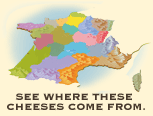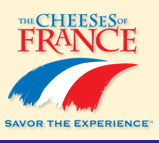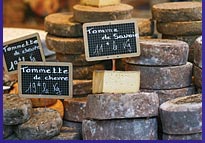The Complex, Diverse Taste of French Mountain Cheeses
From the Alps to the Jura to the Pyrénées, French mountain cheeses are a special delight. Enjoy the complex and diverse flavors of these cheeses, made from the rich milk of ancient breeds that graze in mountain meadows. On this board, the Pyrénées cheeses are on the left (west) moving east to some central Auvergne cheeses and then deep into the French Alps cheeses on the far right of the board (east).
Max’s recommended tasting order: Morbier, Ossau-Iraty, Tomme Pyrénées, Comté, Cantal, Beaufort, Bleu des Basques, Fourme d'Ambert.
The Cheeses
“These are the cheeses that will make you feel like you will live forever!” Max McCalman, Maître Fromager
Morbier (AOC) — Jura Mountains. Morbier is an aromatic and surprisingly mild cow’s milk cheese defined by the dark vein of vegetable ash streaking through its middle — a nod to the method by which it was once produced in Franche-Comté. Aged at least 60 days, Morbier has a mild taste and nutty aftertaste.
If you can’t find it, ask for: Tomme de Savoie, Bethmale.
Comté (AOC) — Jura Mountains. One of the most popular cheeses in France, Comté is produced in the rich mountain pastures of the Jura. Its firm and supple pâte, with holes, or “eyes,” has a nutty, slightly salty yet sweet taste. Comté is produced year-round by small, cooperative dairies known as fruitières.
If you can’t find it, ask for: French Gruyère and Beaufort
Beaufort (AOC) — French Alps. Famous since Roman times, Beaufort is one of the noble cheeses of the French Alps. Made from the milk of an ancient mountain breed of mahogany-colored cows, it has a dense, concentrated, buttery consistency, a fruity aroma and rich, nutty flavors with a hint of sweetness.
If you can’t find it, ask for: Emmental Français, Gruyère de Savoie.
Cantal (AOC) — Massif Central. A distinguished, semi-hard cheese from the central mountainous region of Auvergne, Cantal is a cheddar-like cow’s milk cheese cured with salt, which brings out its full flavor. Heavy and moist, young Cantal has a sweet, milk flavor; well-aged, it has a sharper flavor.
If you can’t find it, ask for: Laguiole, Salers.
Fourme d'Ambert (AOC) — Massif Central. Produced by cooperatives in the Auvergne region, this semi-firm, creamy blue cheese is similar to Stilton but pressed and therefore less crumbly. The cheese is poured into a mold (fourme) shaped like an upright cylinder. Its flavor is buttery and tangy, not salty or bitter.
If you can’t find it, ask for: Bleu d’Auvergne.
“Delightful, very approachable — a primordial type of cheese that lingers a long time in the mouth. Pairs well with red wines.” Max McCalman, Maître Fromager
Ossau-Iraty (AOC) — Pyrénées. A classic sheep’s milk cheese made with the milk of the Manech and Basco-Bearnaise ewes. Aged for at least 90 days, the shape of each wheel can vary from region to region. With an ivory pâte, an aroma of toasted hazelnuts and a sweet, buttery flavor.
If you can’t find it, ask for: Ardi-Gasna, Abbaye de Belloc, P'tit Basque, Kaikou, Chistou, or P'tit Pyrénées.
Tomme des Pyrénées. This round, semi-soft farmhouse cheese (tomme) is large, heavy and solid, with a firm, white, dry and compact pâte and a rich flavor.
If you can’t find it, ask for: Bethmale.
Bleu des Basques — Pyrénées. This artisan sheep’s milk blue cheese is made in the mountains of French Basque country. These verdant hills are full of the wildflowers and fresh grass that give the milk its complexity, subtlety, and lightness. The cheese has earthy, fruity flavors.
If you can’t find it, ask for: Bleu des Causses
“Fairly new to the US, with a sweet, smooth texture...a gentle sheep’s milk cheese.”
Max McCalman, Maître Fromager
All soft-ripened cheeses used in our Signature Fromage Plates are made from pasteurized milk, and therefore comply with FDA regulations.








